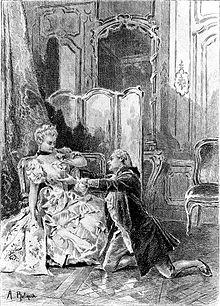Sarrasine

Image from Sarrasine.
|
|
| Author | Honoré de Balzac |
|---|---|
| Illustrator | Alcide Théophile Robaudi |
| Country | France |
| Language | French |
| Series | La Comédie humaine |
| Publisher | Charles Gosselin |
|
Publication date
|
1831 |
| Preceded by | Facino Cane |
| Followed by | Pierre Grassou |
Sarrasine is a novella written by Honoré de Balzac. It was published in 1830, and is part of his Comédie Humaine.
Balzac, who began writing in 1819 while living alone in the rue Lesdiguières, undertook the composition of Sarrasine in 1830. Although he had steadily produced work for over a decade (without commercial success), Sarrasine was among his earliest publications to appear without a pseudonym.
During the period in which the novella was written, Balzac was involved in many salons, including that of Madame Recamier. Around the time in which Sarrasine was published, Balzac experienced great success with another work, La Peau de Chagrin (1831). As his career began to take off and his publications began to accumulate, Balzac developed increasingly lavish living habits and frequently made impulsive purchases (such as new furniture for his apartment and a hooded white cashmere gown designed to be worn by a monk, which he wore at night while writing), likely to distance himself from his family’s prior debt, which had resulted from his business as an editor and printer’s liquidation.
In 1841, an ill Balzac reached an agreement with Furne & Co., Dubochet, Hetzel and Paulin to publish La Comédie humaine. In the 10 years that elapsed, Balzac had developed a political career, becoming heavily involved in high society, which influenced much of his writing. However, he continued to have financial difficulties despite his success, such as with La Cronique de Paris, a magazine he founded and abandoned, though he characteristically hid his worry in order to maintain appearances.
The first volume of La Comedie Humaine went on sale in July 1842. Sarrasine is part of its "Scenes de la vie parisienne".
Balzac's Sarrasine was not paid much attention to prior to Roland Barthes' blow-by-blow structuralist/post-structuralist analysis of the text in his book S/Z(1970). Barthes dissects the text in accordance with five "codes" (hermeneutic, semic, symbolic, proairetic, and cultural).
...
Wikipedia
